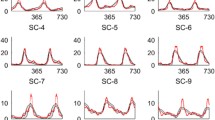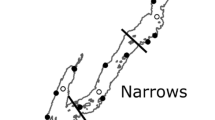Abstract
We performed a methodological study aimed at extending our previously developed approach to quantify the ecological stability of biotic communities and an entire ecosystem, using Lake Kinneret as a case study. The ecological stability of the biotic communities (phytoplankton and zooplankton) of Lake Kinneret was estimated using two different aggregating schemes. The first scheme used the combined stability index, based on the combined indices of the individual phytoplankton (SI[Comb]P) and zooplankton (SI[Comb]Z) taxonomic groups. The total community stability index was calculated based on the total abundances of these communities. The stability of the entire ecosystem was estimated for two sets of ecosystem state variables, a lake “trophic state” set and a “water quality” set, which provided considerably different estimates of the lake ecosystem stability. Good agreement between the results of this study and qualitative estimates of Lake Kinneret stability validates the suitability of this approach to estimate the stability of different ecological units.







Similar content being viewed by others
References
Alimov AF. 2003. Towards a theory of the functioning of aquatic ecosystems. Leiden: Backhuys Publishers. p 130.
Berman T, Yacobi YZ, Parparov A, Gal G. 2010. Estimation of long-term bacterial respiration and growth efficiency in Lake Kinneret. FEMS Microbiol Ecol 71(2010):351–63.
Berman T, Zohary T, Nishri A, Sukenik A. 2014. General background. In: Zohary T, Sukenik A, Berman T, Nishri A, Eds. Lake Kinneret: ecology and management. Heidelberg: Springer. p 1–15.
Carlson RE, Simpson J. 1996. A coordinator’s guide to volunteer Lake monitoring methods. Madison: North American Lake Management Society.
Carpenter S, Walker BJ, Anderies M, Abel N. 2001. From metaphor to measurement: resilience of what to what? Ecosystems 4:765–81.
Cottingham KL, Schindler DE. 2000. Effects of grazer community structure on phytoplankton response to nutrient pulses. Ecology 81:183–200.
Doak DF, Bigger D, Harding EK et al. 1998. The statistical inevitability of stability-diversity relationships in community ecology. Am Nat 151(3):264–76.
Donohue I, Owen L, Petchey OL, Montoya ML et al. 2013. On the dimensionality of ecological stability. Ecol Lett 16:421–9.
Gal G, Anderson W. 2010. A novel approach to detecting a regime shift in a lake ecosystem. Methods Ecol Evol 1:45–52.
Gal G, Hambright KD. 2014. Metazoan zooplankton. In: Zohary T, Sukenik A, Berman T, Nishri A, Eds. Lake Kinneret: ecology and management. Heidelberg: Springer. p 227–45.
Gal G, Hipsey M, Parparov A et al. 2009. Implementation of ecological modeling as an effective management and investigation tool: Lake Kinneret as a case study. Ecol Model 220:1697–718.
Gal G, Skerjanec M, Atanasova N. 2013. Fluctuations in water level and the dynamics of zooplankton: a data-driven modelling approach. Freshw Biol 58:800–16.
Gilboa Y, Gal G, Friedler E. 2014. Defining limits to multiple and simultaneous anthropogenic stressors in a lake ecosystem—Lake Kinneret as a case study. Enviorn Model Softw 61:424–32.
Goberville E, Beaugrand G, Sautour B, Tréguer P. 2011. Evaluation of coastal perturbations: a new mathematical procedure to detect changes in the reference state of coastal systems. Ecol Indic 11:1290–300.
Goldman CR. 2008. Introduction five decades of environmental and social change at Lake Tahoe. In: Bachand T, Ed. Lake Tahoe: a fragile beauty. San Francisco: Chronicle Books. p 14–18.
Greenacre M. 2008. Correspondence analysis and related methods. Department of Statistics, Stanford University, Fall, STA 254. Available from http://www.econ.upf.edu/~michael/stanford/.
Grimm V, Wissel C. 1997. Babel or the ecological stability discussions: an inventory and analysis of terminology and a guide for avoiding confusion. Oecologia 109:323–34.
Groffman PM, Baron JS, Blett T et al. 2006. Ecological thresholds: the key to successful environmental management or an important concept with no practical application? Ecosystems 9:1–13.
Gsell AS, Özkundakci D, Hébert MP, Adrian R. 2015. Quantifying change in pelagic plankton network stability and topology based on empirical long-term data. Ecol Indic 11–12:76–88.
Hainal E, Padisak J. 2008. Analysis of long-term ecological status of Lake Balaton based on the ALMOBAL phytoplankton database. Developments in hydrobiology. vol 199, pp 227–37.
Hambright KD. 2008. Long-term zooplankton body size and species changes in a subtropical lake: implications for lake management. Fundam Appl Limnol 173(1):1–13.
Harte J. 1979. Ecosystem stability and the distribution of community matrix eigenvalues. In: Halforn E, Ed. Systems theory and ecology. London: Academic Press. p 453–65.
Holling CS. 1996. Engineering resilience vs ecological resilience. In: Schultze PC, Ed. Engineering within ecological constraints. Washington, DC: National Academy Press. p 31–43.
Innis G. 1975. Stability, sensitivity, resilience, persistence. What is of interest? In: Levin SA, Ed. Ecosystem analysis and prediction. Philadelphia: Society for Industrial and Applied Mathematics. p 131–9.
Ives AR, Dennis B, Cottingham KL, Carpenter SR. 2003. Estimating community stability and ecological interactions from time-series data. Ecol Monogr 73(2):301–30.
Jax K. 2006. The units of ecology. Definitions and application. Quart Rev Biol 81:237–58.
Justus J. 2008. Complexity, diversity and stability, chapter 18. In: Sahotra S, Plutyns S, Eds. A companion to the philosophy of biology. Malden: Blackwell. p 321–50.
Kindt R, Coe R. 2005. Tree diversity analysis. A manual and software for common statistical methods for ecological and biodiversity studies. Nairobi: World Agroforestry Centre (ICRAF).
Lehman CL, Tilman D. 2000. Biodiversity, stability, and productivity in competitive communities. Am Nat 156:534–52.
McLeod KL, Leslie HM. 2009. Why ecosystem-based management? In: McLeod KL, Leslie HM, Eds. Ecosystem-based management for the oceans. Washington, DC: Island Press. p 3–12.
Milsum JH. 1966. Biological control systems analysis. New York: McGraw Hill.
Muller F, Bergmann N, Dannowski R et al. 2015. Assessing resilience in long-term ecological data sets. Ecol Indic. doi:10.1016/j.ecolind.2015.10.066.
Ofir E, Gal G, Goren M, Shapiro J, Spanier E. 2016. Detecting changes to the functioning of a lake ecosystem following a regime shift based on static food-web models. Ecol Model 320:145–57.
Parparov A, Gal G. 2012. Assessment and implementation of a methodological framework for sustainable management: Lake Kinneret as a case study. J Environ Manag 101:111–17.
Parparov A, Hambright KD. 2007. Composite water quality: evaluation and management feedbacks. Water Qual Res J Can 42:20–5.
Parparov A, Hambright KD, Berman T. 2014. Water quality assessment. In: Zohary T, Sukenik A, Berman T, Nishri A, Eds. Lake Kinneret: ecology and management. Heidelberg: Springer. p 607–16.
Parparov A, Gal G, Zohary T. 2015. Quantifying the ecological stability of a phytoplankton community: the Lake Kinneret case study. Ecol Indic 56:134–44.
Reynolds CS. 2006. The ecology of phytoplankton. Cambridge: Cambridge University Press.
Roelke DL, Zohary T, Hambright KD, Montoya JV. 2007. Alternative states in the phytoplankton of Lake Kinneret, Israel (sea of Galilee). Freshw Biol 52:399–411.
Rudstam LG, Mills EL, Jackson JR, Stewarts DJ, Eds. 2016. Oneida Lake: long-term dynamics of a managed ecosystem and its fishery. Bethesda, Maryland: American Fishery Society.
Rykiel EJ. 1985. Towards a definition of ecological disturbance. Aust J Ecol 10:361–5.
Sommer U, Ed. 2012. Plankton ecology. succession in plankton communities. Brock series in contemporary bioscience. New York: Springer.
Sukenik A, Zohary T, Markel D. 2014. The monitoring program. In: Zohary T, Sukenik A, Berman T, Nishri A, Eds. Lake Kinneret: ecology and management. Heidelberg: Springer. p 561–75.
Tett P. 2015. Guide to the plankton index method and software, Vol. 3Oban: Scottish Association for Marine Science. p 27.
Tilman D. 1996. Biodiversity: population versus ecosystem stability. Ecology 77(2):350–63.
Tilman D. 1999. The ecological consequences of changes in biodiversity: a search for general principles. Ecology 80(5):1455–74.
Ulanowicz RE. 1978. Modeling environmental stress. In: Thorpe H, Gibbons JW, Eds. Energy and environmental stress in aquatic systems. DOE symposium series (CONF- 771114). Springfield, Virginia: National Technical Information Service. p 11–18.
Umnov AA. 1997. A study of ecosystem “stability” using a mathematical model. In: Alimov AS, Bul’on V, Eds. The responses of lake ecosystems to changes in biotic and abiotic conditions. Proceedings of Zoological Institute, Saint-Petersburg, vol. 272, pp 303–10.
Walker B, Carpenter S, Anderies N and others. 2002. Resilience management in social-ecological systems: a working hypothesis for a participatory approach. Conserv Ecol 6(1): 14. [online] URL: http://www.consecol.org/vol6/iss1/art14/.
WFD. 2000. European Water Framework Directive 2000/60/EC of the European Parliament and of the Council of 23 October 2000 establishing a framework for community action in the field of water policy. Off J Eur Community L327.
Winberg GG, Ed. 1985. The ecological system of the Naroch Lakes. Minsk: Universitetskoye Press. p 289 (in Russian).
Yacobi YZ, Erez J, Hadas O. 2014a. Primary production. Chapter 24. In: Zohary T, Sukenik A, Berman T, Nishri A, Eds. Lake Kinneret: ecology and management. Heidelberg: Springer. p 657–71.
Zar JH. 1998. Biostatistical analysis. Englewood Cliffs, New Jersey: Prentice Hall International, INC. p 147.
Zohary T, Sukenik A, Berman T, Nishri A, Eds. 2014a. Lake Kinneret: ecology and management. Heidelberg: Springer. p 683
Zohary T, Sukenik A, Nishri A. 2014b. Lake Kinneret: current understanding and future perspectives. Chapter 27. In: Zohary T, Sukenik A, Berman T, Nishri A, Eds. Lake Kinneret: ecology and management. Heidelberg: Springer. p 417–438
Zohary T, Yacobi YZ, Alster A, Fishbein T, and others. 2014c. Phytoplankton. Chapter 10. In: Zohary T, Sukenik A, Berman T, Nishri A, Eds. Lake Kinneret: ecology and management. Heidelberg: Springer. p 161–190
Acknowledgements
We thank two anonymous Reviewers whose valuable comments greatly contributed to the improvement of the manuscript. We used the Kinneret Limnological Laboratory database, which is a part of the Lake Kinneret ecological monitoring program sponsored by the Israel Water Authority. We are very thankful to L. Baumer for her valuable help in preparing and editing this manuscript.
Author information
Authors and Affiliations
Corresponding author
Additional information
Author contributions
Dr. A. Parparov: Conceived of study, analyzed data, contributed new methods, wrote the paper; Dr. G. Gal: Analyzed data, developed new methods, wrote the paper.
Rights and permissions
About this article
Cite this article
Parparov, A., Gal, G. Quantifying Ecological Stability: From Community to the Lake Ecosystem. Ecosystems 20, 1015–1028 (2017). https://doi.org/10.1007/s10021-016-0090-z
Received:
Accepted:
Published:
Issue Date:
DOI: https://doi.org/10.1007/s10021-016-0090-z




